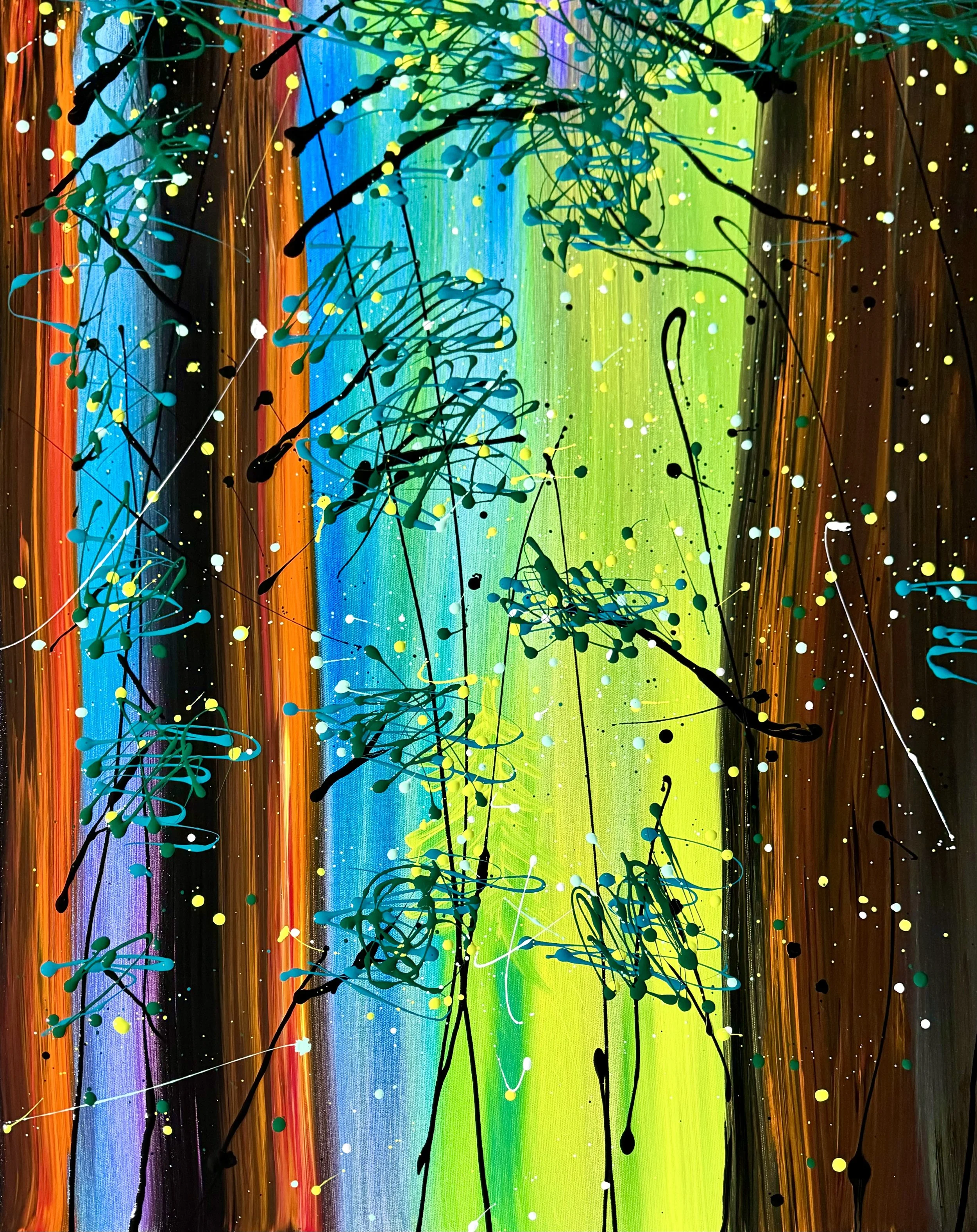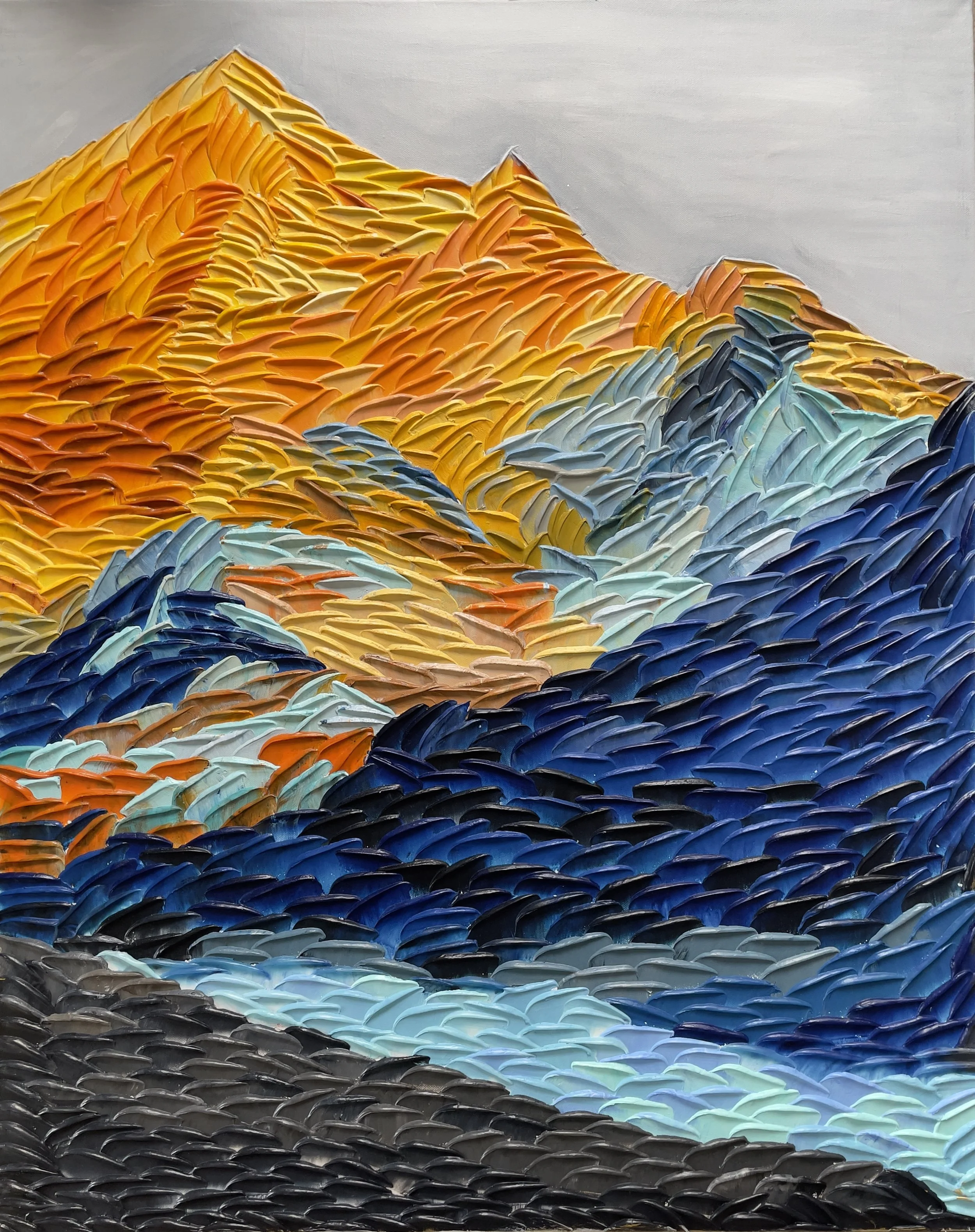Michael W. Surber's artistry is a striking display of color's emotive force and an adventurous exploration of form. His approach to painting is dynamic, marked by a tactile and often thick application of paint that seems to jump off the canvas, engaging the viewer directly. Surber's skillful use of a wide range of colors, from fiery reds and oranges to calming blues and greens, exhibits his deep understanding of color theory and its emotional resonance.
All in Contemporary Art
Sodoma X
The digital art of Sodoma Xia is a profound exploration of the darker aspects of the human psyche, manifested through a digital medium. Her art is a testament to the shadowy corners of the soul, where fear and beauty coalesce into a singular, overwhelming experience. Each piece is a maelstrom of emotion, imbued with a sense of the infinite and the nocturnal. Xia's palette is a sophisticated symphony of darkness, where colors merge into each other, both hiding and revealing forms in a dance that is as much about what is seen as it is about what is suggested.
Katrin Loy
The photographic oeuvre of Katrin Loy is an intricate tapestry of emotional depth and cerebral landscapes, a profound exploration of the human psyche in its most unguarded state. In Loy's artistic statement, she professes an intent to delve into the essence and soul of humanity, capturing the perennial struggle for vision, the constant grappling with utopias and abysses, and the intimate encounter with the self and the other.
Patrick Joosten
Patrick Joosten stands out as a self-taught virtuoso in the abstract art scene, crafting pieces that are as spontaneous as they are meticulously thought out. His canvases serve as more than mere backdrops; they are vibrant arenas where color, texture, and form unite to orchestrate a complex visual experience. Joosten’s oeuvre is a compelling reminder of abstract art’s ability to stir emotions, prompt introspection, and challenge the viewer’s perspective.
Danny Van der Elst
Danny Van der Elst's photography captures the delicate interplay of light and shadow, creating an evocative dance across the contours of the human body. These images are a testament to the photographer's mastery of visual storytelling and command of the camera. The use of natural light to sculpt the subjects’ features brings a sense of raw authenticity and vulnerability to each composition.
Interview with Svetlana Malakhova
Svetlana, please share some of your earliest experiences or influences that led you to pursue an art career, mainly focusing on the human theme?
Actually, during my studying I had already understood that the most interesting theme for me is the human body. I distracted from humans, only during summer practice when we were focusing on landscapes and spent a lot of time painting fields and trees or parks and rivers not far from Moscow. So, during summer time, I was engrossed in landscape painting, but when I came back to Academy walls, I began to create with a new energy new artworks with human bodies and work with models. I think it had always been in my subconscious mind, but my mind understood it a little bit later. Then, I almost stop to work with any theme but humanity and I think one life is not enough to open this enormous and huge question.
Interview with Jianhui Ren
Mr Ren Jianhui, born in ChenDu, China. He graduated from Art Academy of Qing Hua University, his teacher was the art master Mr. Wu Guanzhong. He was selected as “Top 60 Masters of International Contemporarty artists” in 2013 by USA, Canada and Italy, he is also the first South East Asia artist to get this nomination. Mr. Ren Jianhui used to teach in National University of Singapore. He is the president of Artists Society of Singapore (2002 till present) and a member of China Artists Association.
Interview with Yuiko Amano
Transitioning from a science-based career to an art-focused one, what have been some of the most challenging and rewarding aspects of this journey?
No matter what I do, there will be challenges. I have a career in which I moved from science to architecture and then to art, but that was because I had a keen interest to know more at the time. I still have that interest today. Creative endeavours can sometimes have a glamorous, stage-like aspect, but in my opinion, after all, they are ‘self-reflection through expression.’ It is about thinking about ‘our own language’.
Interview with Milena Bini
In your varied artistic journey, starting in adolescence, what initially led you toward art as a form of expression and how has this inspiration evolved over time?
Art was initially therapeutic for me, the medium that allowed me to express my states of mind. I remember in my early adolescent conflicts feeling a strong uneasiness, running to the attic, grabbing everything I had on hand: sand, paper, paints, glues, etc., and instinctively transferring my malaise to canvas or board. Art was my salvation. This is precisely why I enrolled in one school after another to learn how to express myself better in this language. The real passion blossomed in high school where I had the good fortune to meet good teachers who passed on to me a love of art history and human figure drawing; attending classes got me hooked on oil painting, over time I experimented with different techniques and expressions in various artistic fields, I was thirsty to learn.
Interview with Giovanni Gambasin
Giovanni Gambasin, born in 1951, started out in a family that was foreign to the artistic world. However, destiny led him on a unique artistic path, growing up in an unusual context: his father was sacristan of a small church in Crespano del Grappa, designed by none other than Antonio Canova as a 'dress rehearsal' for the Canovian temple in Possagno, the neoclassical artist's birthplace. A certainly peculiar context for the training of an artist.
Interview with Maja Pavlovska - Maja Angel
How has your journey from Macedonia to the Netherlands influenced your artistic style and themes in your paintings?
First of all I would like to express the honor, happiness and thankfulness to you and the whole team of Contemporary Art Curator, for giving me this great opportunity to present my art journey to your visitors and audience world wide, who are interested in art. I hope that my art journey will be interesting for them, as well.
Interview with Sharon Volpe
How do you balance the use of traditional painting techniques with modern digital tools in your creative process?
Well, every day I draw or paint traditionally either in my sketchbook or by just creating small works with ink to keep myself loose. At that point, I will transfer those ideas digitally and or enlarge them and make larger paintings. Digital transforming can allow me to make them into affordable prints, cards and stickers, and even a book. A larger painting would be if I may want to submit to a gallery show.
Atom Hovhanesyan
Atom Hovhanesyan's artistic journey, as experienced through his oeuvre, is a profound narrative of emotional depth, technical brilliance, and a relentless pursuit of a distinct visual language that speaks to the complexity of human experience. Born in Yerevan, Armenia, and later becoming a vibrant part of the New York art scene, Hovhanesyan's work is a testament to the power of art to transcend boundaries, both geographical and psychological.
Mae Jeon
Mae Jeon's digital fine art is a vibrant testament to the interplay between technology and spirituality. Her artistry is distinguished by the use of floral subjects as a metaphorical canvas where spiritual ideas and divine vocabularies come to life. The carefully curated flowers in her compositions serve not just as objects of beauty but as profound symbols conveying themes of fragility, resilience, and eternal life.
Bex Wilkinson
Bex Wilkinson's paintings can be described as a vivid exploration of the abstract and figurative, where the visceral meets the ephemeral. Her work is a dance of colors and forms, a visual symphony that captures the complexities of emotion and the subtleties of the human condition. Wilkinson’s technique is reminiscent of the action painting of the Abstract Expressionists. Yet, it bears a personal stamp that is undeniably unique. The dynamic strokes, the splattering of paint, and the bold, sometimes almost violent application of color, create a sense of movement that is almost palpable. There is an urgency in her brushwork, a need to convey not just an image but a sensation, a feeling, an experience.
Ori Aviram
Ori Aviram’s paintings represent a distinct fusion of emotion, texture, and color, creating a vibrant tapestry that speaks to the human experience in its rawest form. His work transcends the traditional confines of canvas and pigment, offering instead a glimpse into a world where feeling and form collide with profound intensity.
Elena Shuppo
Elena Shuppo's artistic oeuvre enchants the viewer with its profound investigation of form and color, as exquisitely showcased in the mesmerizing series of images presented. The artist's creations possess a remarkable architectural quality, characterized by the enchanting utilization of geometric forms that transcend the confines of their two-dimensional canvas, seemingly reaching into the realm of three-dimensionality. The seamless fusion of architectural elements and artistic expression in Shuppo's work serves as a profound testament to the artist's remarkable talent for reshaping both physical spaces and our very perceptions.
Michael Kaphengst
Michael Kaphengst's artwork presents an intriguing exploration of color, form, and texture, displaying a unique and distinctive voice within the contemporary art scene.
The artist's sense of colour captivates the viewer, as vibrant hues harmoniously dance across the canvas, beckoning one to immerse themselves in the captivating world of the artwork. The artist's masterful manipulation of form traverses the realms of abstraction and representation, giving birth to a captivating visual discourse that both challenges and captivates the viewer.
Gayathrisai (Gaya) Chandrasekaran
Gaya Chandrasekaran's exquisite collection of artworks orchestrates a harmonious blend of texture, color, and emotive prowess, captivating the senses and beckoning the viewer into a realm of profound contemplation. The artist's oeuvre is distinguished by a daring exploration of impasto technique, wherein the application of paint is executed with such audacity that the viewer is immediately captivated by the discernible knife or brush strokes. This deliberate choice bestows upon each artwork a remarkable three-dimensional quality, allowing it to command a tangible presence within the realm of visual perception. The artist's masterful manipulation of texture beckons the viewer to engage with the artwork on a multisensory level, transcending the boundaries of mere visual perception.
Interview with Tim Taylor
Can you tell us about your background and what initially drew you to the world of art? Were there any significant influences or experiences in your early years that shaped your decision to become an artist?
I grew up in the days of The Beatles, Rolling Stones, and Peter Max. My parents loved and encouraged the arts, so as a child I had art lessons, music practice, and was in theater. I was just a kid who liked to make stuff and do things. In high school my art teacher was very encouraging. I didn’t really like many of the classes except art, band, and drama. Art was a time you could make whatever you wanted, and you could imagine anything. The assignment to “paint whatever you want” worked for me.




















